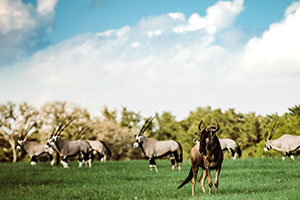Should I Worm My Exotics

Exotic animal species are becoming more and more common when it comes to properties that are being managed for recreational or commercial hunting. This is primarily due to the fact that they can be hunted year-round which all hunters like and can also bring in some much-needed supplemental income for commercial properties in the off season. Exotics are not really picky eaters for the most part but there are still some things you should be concerned with when it comes to managing exotic species especially when it pertains to ranches with high populations of multiple species of exotics within the same pasture.
The most common issue I see with exotics in confinement are internal parasites. It is imperative to have a fecal monitoring program to be sure you do not reach parasite load threshold with exotics especially with captive animals in pens. The only way to stay ahead of it is with a good monitoring program where you’re checking fecals hopefully at least quarterly and worm with an effective anthelmintic if needed. While this is relatively easy inside a pen where we know whose poop came from who, it can be extremely difficult in a large pasture with multiple species. It is important to call out that all species need to be monitored independently as each will have a different tolerance or threshold for particular internal parasites before you see negative herd implications. This presents a big challenge for managers from a fecal monitoring standpoint in the pasture and why most typically elect to worm at certain times of the year regardless of if they have issues or not.
With pasture animals our only option for worming exotics is typically with a feed through anthelmintic. The most commonly used for feed inclusion is fenbendazole/Safe-Guard due to being extremely safe to feed with no clearance required while showing an extremely high level of efficacy in herds that are conditioned to consuming supplemental feed. It is imperative that animals consume the feed consistently in order to see good control. For animals in confinement, it is typically recommended that animals on our Apex Dewormer w/Safe-Guard be fed at full feed for at least 3 days. That basically equates to 1 bag for every 4 head of exotics that are 200# or less. Larger exotics may require a higher safeguard inclusion or feeding rate to see good efficacy. For pasture animals, I typically recommend a little longer treatment to be sure all have adequate access to the feed. This typically means feeding 1 bag of Apex Dewormer for every 3 head of exotics.
As I mentioned above, it helps to have a fecal monitoring program to know if you have internal parasites and also determine which ones they are. While Apex Dewormer with Safe-Guard is effective against a broad scope of parasites, there are some rare occasions when a different anthelmintic may be required to see adequate control and the only way to determine this proactively is with fecal screening. This can be done with relative ease with animals in a pen, but again is extremely difficult in large pastures that contain several different species of exotics. Due to its safe nature and relative ease of application in herds that are conditioned to consuming supplemental feed most exotic ranches follow the traditional domestic livestock protocol and worm their pasture animals in the fall after first frost or before Thanksgiving and again after first initial spring green up.
As I always say every ranch is different and therefor the management of each should vary in turn. This holds true for both supplemental feeding and worming protocols. There are so many variables to consider when it comes to feeding exotics that many managers will often overlook. Attached with this are more information regarding safeguard and its use with exotics, but I would recommend discussing a feeding plan with a nutritionist every year to be sure you are meeting the demands of your herd based on numbers and existing habitat conditions. Please feel free to contact us anytime for a free feeding evaluation.
